#and many orgs do have on their pages why they picked the breeds they do
Text
SD organizations are moving away from poodles left and right because of the high wash rates (and numerous ones will even say that's why lol) and people still push them as a fab four breed (along with collies and gsds, yikes) 💀
there's a reason almost all accredited organizations use labs, goldens, or labxgolden mixes... it's because they have the best and absolute highest success rates out of any breed, hugely ahead of all other breeds in their success rates
and like, i am the FIRST to admit that sometimes off breeds can become SDs, i worked a BC, but the fact is.. one can set themselves up for success by going with a lab or golden (or labxgolden)
#service dog shitposting#wild rambles#gonna be honest i literally do not care if you dont agree#and probably wont respond im here to drop a UO and bounce#but ive worked three dogs and none of my dogs were behavioral washes *flex*#and two retired due to age *flex*#and this is one of my special interests so yes#ive gone through nearly every ADI accredited organization and looked at their breeds and breed pages lol#b/c im disabled and bored and wanted to make the best choices#i went with another golden for a reason#and many orgs do have on their pages why they picked the breeds they do#and the large majority ARE labs/goldens/labxgolden mixes#solely for success#and yes i know some people need hypo dogs i get it#still tho lol
14 notes
·
View notes
Text
7 Successful Amazon Affiliate Websites (That You Can Learn From)

Heard a lot about Amazon affiliate websites but have no idea where to start? Take inspiration from these seven examples.
Amazon affiliate websites make money via commissions from their affiliate program: Amazon Associates.
Here’s how this works:
A person visits an Amazon affiliate site.
They click on an affiliate link to buy a recommended product on Amazon.
Amazon pays the site owner a commission.
In this post, we’ll share some inspiring Amazon affiliate websites, why they’ve done so well, and how you can replicate their success.
Let’s get things started.
1. The Prepared

Key stats
Domain Rating: 36
Number of referring domains: 901
Number of keywords it ranks for: 40,600
Estimated organic traffic: 31,900
Site age: 2 years
Estimated revenue: Unknown
Founded by John Ramey and John Adama—former advisors at the Obama White House—The Prepared is a survivalism website that publishes practical guides on preparing for emergencies ranging from potential car accidents to war.
Why they’re doing so well
For starters, the doomsday prepper market is huge. According to Finder.com, an estimated 160+ million Americans have either recently purchased survival gear or are already in possession of some.
Of course, The Prepared is not the only website focused on survivalism. There are tons of websites in this niche.
The success of this particular site falls largely down to its owners’ focus on creating content about evergreen topics.
Evergreen topics are those with consistent interest and search volume over time. For example, we can see that The Prepared targets keywords like “best tarp.”
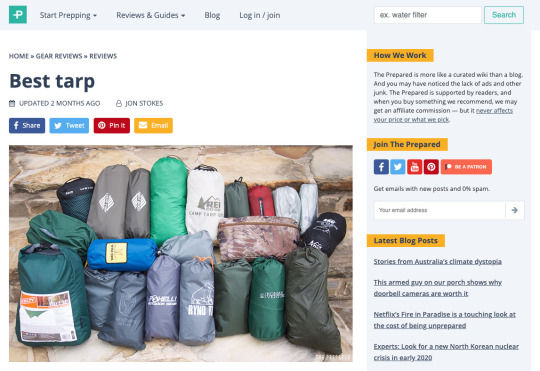
According to Google Trends, this is a topic with increasing interest over time:
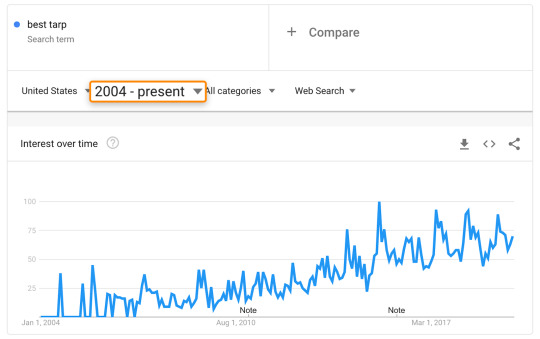
They’re also committed to updating their content regularly to keep it evergreen. After all, a list of the best tarps won’t stay fresh forever since new products are released all the time.

If they update something, they’ll mention what changed in the post:

The benefits of this approach are obvious:
They don’t have to worry about waning interest in their topics. People will still be searching for “best tarp” 5 years from now.
They can get consistent organic traffic over time. Google tends to favor fresh results for queries like “best tarp” because old posts are out of date and no use to searchers in 2020. By publishing regular, minor updates as new products become available, the guys behind The Prepared can maintain rankings long term.
What also makes them stand out is the quality of their content.
For their reviews, they test every product before publishing, and they’re transparent about the testing process.
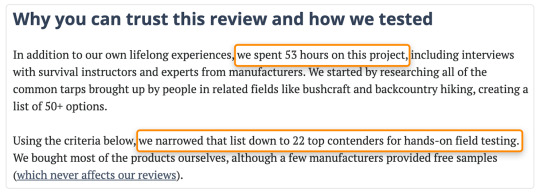
Essentially, this is the Wirecutter model (we’ll talk more about them later!). The Prepared simply took the idea and focused on a single niche.
How to replicate their success
Focus on creating “best ” posts for evergreen product categories. These are things that people will still be looking to buy in years to come.
For example, a list of the best dishwashers has longevity since there are always people in the market for a new appliance.
That’s why Google Trends shows consistent search demand over time.

Of course, some topics are seasonal such as “best tents.”

This isn’t an issue because its popularity is consistent year over year. You’ll just experience more sales during certain parts of the year.
What you want to avoid are non-evergreen topics with waning interest, like “best fidget spinner.”

The benefit of creating content about evergreen product categories is that it has the potential to attract organic traffic long term. Just make sure your SEO strategy is sound and you keep the posts updated.
Learn more about how to do this in our guide to evergreen content.
2. Homegrounds

Key stats
Domain Rating: 63
Number of referring domains: 1,320
Number of keywords it ranks for: 136,000
Estimated organic traffic: 244,000
Site age: 3 years
Estimated revenue: Unknown
Homegrounds is a site that teaches “home baristas” how to brew and enjoy better quality coffee.
Why they’re doing so well
I reached out to the site’s founder, Alex Azoury, to find out.
Here’s what he said:
Firstly, we commit to publishing content that is better than our competitors. This is because the coffee brewing market are switched on, and they definitely appreciate content that actually solves their problem, rather than content built to simply target a keyword.
Secondly, we reverse engineer our competitors via Ahrefs’ Site Explorer to uncover content and backlink opportunities that are working for them. If it works for them, it will most likely work for us.
Finally, we dig deeper into keywords and think about search intent, rather than just looking at search volume. The topics that eventually perform the best from a financial perspective are rarely the ones that look the best on face value. Again, Ahrefs’ Keywords Explorer has been an invaluable resource for this.

Alex Azoury, Founder & Editor
How to replicate their success
If we distill what Alex said above, we see that what worked for the Homegrounds team is to focus on the basics:
Do keyword research and find topics with traffic potential.
Create content that aligns with search intent and trumps everything else on quality.
Build links to the content by replicating competitors’ link building strategies.
Learn how to do this in our guide to ranking on the first page of Google.
3. Dog Food Advisor

Key stats
Domain Rating: 76
Number of referring domains: 5,890
Number of keywords it ranks for: 203,000
Estimated organic traffic: 594,000
Site age: 11 years
Estimated revenue: Unknown
DogFoodAdvisor is a site that helps pet owners make better decisions when buying dog food.
Why they’re doing so well
The pets market is enormous. It’s estimated that $75 billion was spent by pet owners in 2019, with $31 billion on pet food alone.
And therein lies the key to this site’s success. Instead of writing broadly on pets or even pet food, they chose to focus solely on dog food.
It also helps that the keyword “dog food” has a global search volume of 117,000 searches per month.

This focus helped them to stand out in a saturated niche, and almost certainly also helped them to rank for thousands of dog food-related keywords.
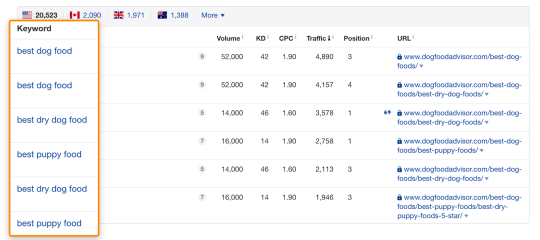
How to replicate their success
There are plenty of things to emulate, but lets drill down on two aspects:
1. Create content hubs
Their page on the “best dog foods” ranks for over 1,300 keywords, sending them an estimated ~20,284 US search visits per month.
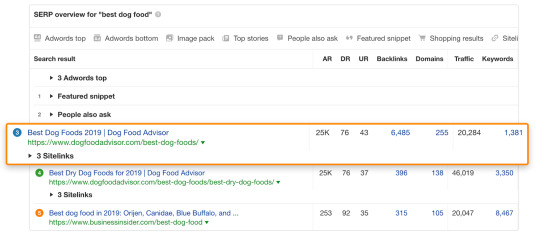
Given that there are so many types of dog foods available for different breeds and for various purposes, it would be impossible to answer the question of “what is the best dog food” in a single article.
Instead, what this page does is internally link to more specialized articles on the subject, allowing readers to choose the one that applies most to them.
This is known as a “content hub.”

Besides creating a better user experience, “hub” pages are also beneficial for SEO. This is because more “authority” is transferred to DogFoodAdvisor’s most important pages as subpages link back to hub pages and vice-versa).
This is almost certainly part of the reason why this page is ranking so well.
Learn more about the types of content hubs in this post.
2. Create useful content that attracts links
Dog food recalls are surprisingly common but also easy to miss.
DogFoodAdvisor solves this problem with their up-to-date list of dog food recalls.

To date, this page has links from 390 websites.

Takeaway: Don’t focus solely on “best ” keywords. Create useful, informational content that attracts links and boosts your authority.
Learn more about how to create content that attracts links.
4. PCPartPicker
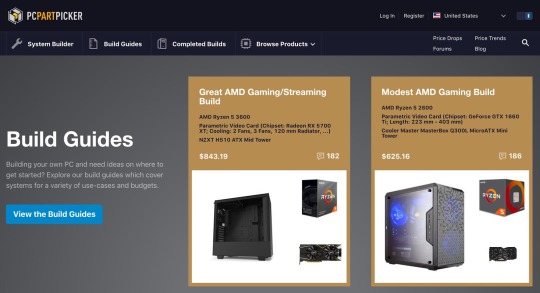
Key stats
Domain Rating: 74
Number of referring domains: 8,810
Number of keywords it ranks for: 785,000
Estimated organic traffic: 3,100,000
Site age: 9 years
Estimated revenue: Unknown
Many people want to build their own PC, but the process isn’t that straightforward—particularly for newbies.
This is where PCPartPicker excels.
Choose the parts you want for your PC, and PCPartPicker will provide compatibility guidance and up-to-date pricing. They also publish “build guides” for those who are unsure how to start building one.
Why they’re doing so well
PCPartPicker is interesting because it deviates from the traditional affiliate model of targeting “best ” keywords.
Instead, it’s a tool.
Knowing which components to buy is a big problem in the “build your own PC” world. PCPartPicker solves this by letting you shop for the latest PC parts based on performance and budget. It then automatically cross-references them to check for compatibility.
Then, based on what you’ve configured, you can purchase directly from Amazon (with PCPartPicker’s affiliate links.)
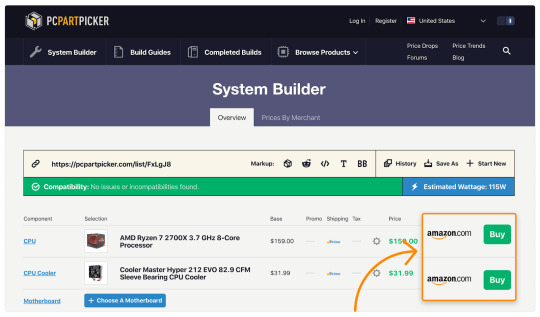
The most remarkable part about this is how much trust the site has built with its audience.
A big issue with affiliate sites is they often recommend products based on the highest commissions. This “strategy” quickly erodes trust, causing many affiliate sites to fail.
But PCPartPicker’s tool is unbiased. It doesn’t push any particular products. All it does is allow users to choose their own configurations, and then make commissions off those choices.
Because the tool is so useful, it markets itself via word-of-mouth.

Along the way, the tool page itself has picked up 835 referring domains—many of which come from authoritative, high-DR sites like The Verge, PC World, etc.

How to replicate their success
Not all Amazon affiliate websites must be “content sites” to do well. There are other ways to excel.
Is there a big problem in your niche? Can you build a free tool or resource to help fix that problem and potentially make some affiliate income along the way?
Sometimes, you have to think outside the box.
Learn more about how to find these opportunities in this guide (skip to example #4)
5. Equipboard

Key stats
Domain Rating: 58
Number of referring domains: 2,560
Number of keywords it ranks for: 722,000
Estimated organic traffic: 354,000
Site age: 5 years
Estimated revenue: Unknown
Equipboard is a site that showcases the gear, tools, and products used by famous musicians.
Content on the site is partially user-generated. The founders (Giulio and Michael) review products and create content targeting “best” keywords, and users contribute content about the gear their favorite artists use.
Why are they doing so well?
As an affiliate site, Equipboard targets “best” keywords in their niche. That’s to be expected.
But they also tackle the affiliate model from a unique angle.
A big part of their site is the breakdown of the gear and tools that famous musicians use.
That’s pretty smart. In the music world, people want to be more like their idols. They want to play the guitar like Slash, rap like Eminem, or sing like Ariana Grande. Not only that, they want to use the same gear as these people.
In fact, Giulio, the co-founder, says this is how Equipboard started.
As musicians ourselves, we understand how musicians search for a certain sound and shop for gear. That led us to create a site around the way people explore gear, specifically by looking up to the pro musicians they admire.

Giulio Chiarenza, Co-founder
This is also where Equipboard takes it to the next level.
Think about it: there are thousands of musicians from every possible genre. It would take them forever to cover every single one of them.
The solution? Enlist the help of their audience. On Equipboard, anyone can add content related to their favorite artists’ gear. Then, with the help of a few community moderators, the founders fact-check sources and ensure the suggestions are accurate.
This allows them to scale content production at a relatively low cost.
It also helps them to:
Get traffic. Most of these musicians are famous, so there’s plenty of search volume for relevant terms (e.g. “jimmy page gear”.)
Get affiliate link clicks. Since fans are already interested in the gear of their favorite musicians, it is likely they will click on their affiliate links.
Get backlinks. Since they’re the most credible source for musicians’ tools and gear, they get tons of links from Wikipedia and other reputable sites.
How to replicate their success
Equipboard’s key to success is their unique selling point (USP): the breakdown of tools and instruments that famous musicians use.
But here’s the cool part: you can apply this same concept to other niches.
Run a golf site? There are plenty of people searching for what’s in the bags of famous golfers.

Run a book review site? People want to know what books famous people recommend.
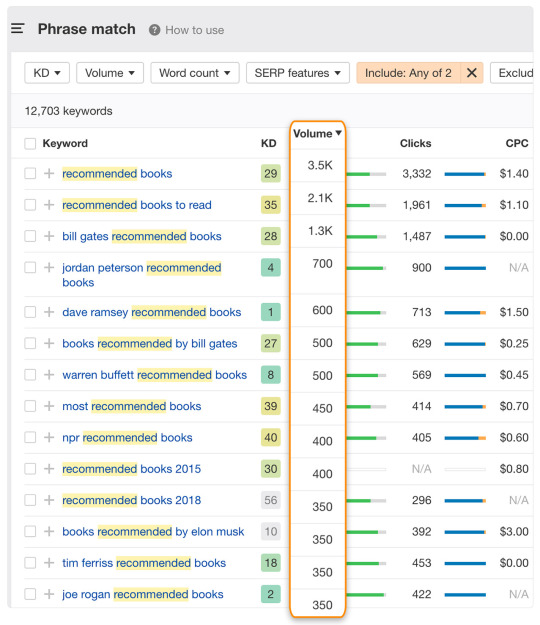
The examples are endless. You just need to find them, which is where a keyword research tool like Ahrefs’ Keywords Explorer (pictured above) comes in handy.
6. Territory Supply

Key stats
Domain Rating: 26
Number of referring domains: 275
Number of keywords it ranks for: 27,700
Estimated organic traffic: 26,600
Site age: 4 years
Estimated revenue: ~4‑figures per month
Territory Supply helps people find hiking, camping, backpacking, and travel adventures in the US, while also showcasing the best outdoor gear they should use.
Why they’re doing so well
The first thing you’ll notice when you visit Territory Supply is how much it looks like an online magazine, rather than a typical affiliate site.
And indeed, they do run their site like a magazine. As an affiliate site, they have articles targeting “best x” keywords. But they also cover plenty of other topics that don’t link to any products.
They’re also committed to linking to the best products, even if they can’t make money from their recommendations.
For example, their post on “DIY teardrop camper kits” generates an estimated 1,800 search visits per month, but has only one link to an affiliate product.

Dustin Christiensen, the founder, reaffirms my thoughts.
I think one reason we’ve had success with Territory Supply is that we’ve tried to provide more value than your average affiliate site. For example, a lot of our product recommendations come from small brands or retailers that don’t have an affiliate program whatsoever. But, those brands make some of the best products, so we’ve included them in our content because that’s what’s most valuable to our readers. We don’t just find five Amazon products and call it a day—we’ll put a lot of research into each product category to find unique products and brands that no one else is discussing since most sites can’t make money off of them.
Secondly, we’ve invested heavily in our brand and appearance. Instead of putting up a cheap WordPress theme, I spent thousands of dollars on a custom designed website with some unique outdoor aesthetics that work well for the outdoor community. We tried to build something that didn’t look like a cheap, thin affiliate site and instead, wanted something that looked trustworthy, valuable and impactful.
Last, we also do a lot of content that isn’t related to products or affiliate marketing at all — like hiking and camping guides that include the best locations to explore in different areas. These articles are research-intensive and we try to find writers who live in or explore the areas we write about so that they have real, accurate value for our readers. We do so much more than just product-based content that I think it helps find an audience that a lot of affiliate sites might miss out on.

Dustin Christiensen, Founder
How to replicate their success
Not every Territory Supply reader is ready to buy. Sometimes, they’re just curious.
And when they read articles like “10 Stunning Hikes in Death Valley National Park”, they might be inspired to start exploring the outdoors more often. Or they might even be fired up to start hiking on the coming weekend.
This will lead them to wonder about the gear they’ll need for hiking, which Territory Supply also helps with.
The takeaway: just because you run an affiliate site doesn’t mean you should only cover “best” or “review” topics. You should target topics at every stage of the marketing funnel.
Learn how to do this in our guide to finding and mapping keywords to the buyer’s journey.
7. The Wirecutter

Key stats
Domain Rating: 82
Number of referring domains: 23,100
Number of keywords it ranks for: 3,700,000
Estimated organic traffic: 4,100,000
Site age: 8 years
Estimated revenue: ~$10 million (2016)
Founded in 2011 by Brian Lam, a former Editorial Director at Gizmodo, The Wirecutter has grown into perhaps the most famous and well-known Amazon affiliate site on the planet.
Frustrated with the never-ending chase for pageviews in traditional media companies, Brian quit Gizmodo and started The Wirecutter as a small review site focused on gadgets.
It was acquired by the New York Times in 2016 for $30 million.
Why they’re doing so well
Short story: they rank on the first page for 62,000+ “best” keywords in the U.S. alone:

The longer story: they’re the absolute champion of product reviews.
When it comes to “best ” type posts, most affiliate sites simply curate whatever’s currently selling well on Amazon.
Not The Wirecutter.
For every category, they’ll thoroughly sample and test every major product. Where needed, they’ll hire professional reviewers.

They’re also transparent about how they test the quality of those products.
Further, to prevent bias, the staff writers are not informed about what commissions the site receives for different products.
And that’s not all. The Wirecutter understands that not everyone wants to read a lengthy review. They just want a reliable and trustworthy source to tell them which product to buy.
So, in the first paragraph of every post, they get straight to the point. They build your trust by telling you how they researched it, then telling you exactly what to buy.
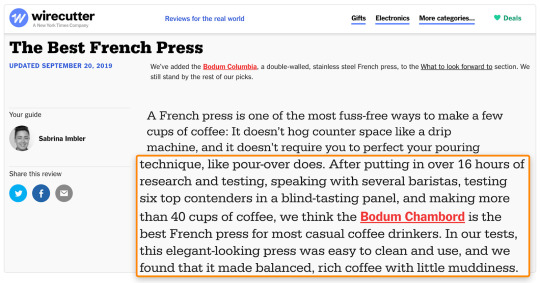
For the impatient, this is perfect. They can click through immediately and make the purchase.
But even if they don’t buy right away, it’s okay. For Amazon affiliate sites, the click itself is important. After all, Amazon has a 24-hour cookie, which means that the site owner will receive commission on anything the person buys in the next 24 hours.
That said, The Wirecutter doesn’t just cater to the impulse buyer.
For those who are obsessed with researching every aspect of a purchase, there’s plenty of research to read.

How to replicate their success
Focus on creating thorough, well-researched posts for “best ” type keywords in your industry. That means testing the products yourself where possible, and potentially even coming up with innovative ways to do so.
If you’re starting out and can’t afford to purchase every product in the category, focus on delivering in-depth research.
Not only does this approach build trust with readers and entice affiliate link clicks, but it also helps to attract backlinks.
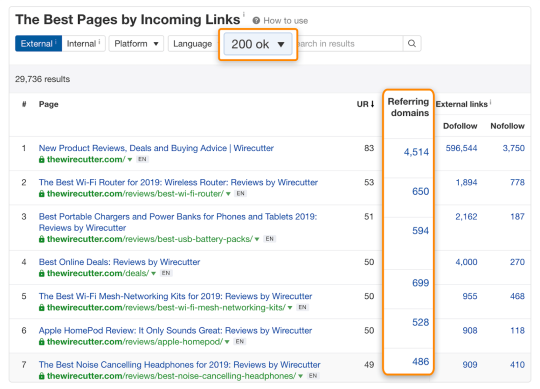
That said, while the quality of content certainly plays an important role here, we also suspect that employing an inhouse SEO team doesn’t hurt matters.

And that brings us to a crucial point:
You shouldn’t try to replicate this model like for like on a site that reviews everything under the sun. Niche down and do things on a smaller scale.
Coming full circle, that’s what The Prepared did in the preppers niche—and it worked out pretty well for them.
Final thoughts
Most successful Amazon affiliate sites follow roughly the same formula:
They target commercial investigation keywords like “best ”;
They create best-in-class content by actually reviewing products;
They work hard to build and attract backlinks to improve rankings.
None of this is rocket science. It just takes hard work, persistence, patience, and a focus on long-term over short-term results.
Read the full article
#amazonaffiliateaccount#amazonaffiliatecommission#amazonaffiliateindia#amazonaffiliatelinks#amazonaffiliatelogin#amazonaffiliatemarketing#amazonaffiliatemarketingprogram#amazonaffiliateprogram#amazonaffiliateprogramrequirements#amazonaffiliateprogramsignin
0 notes
Quote
Quarkus is a new technology aimed at cloud development.
With Quarkus, you can take advantage of smaller runtimes optimized for the cloud.
You don’t need to relearn new APIs. Quarkus is built on top of the best-of-breed technologies from the last decade, like Hibernate, RESTEasy, Vert.x, and MicroProfile.
Quarkus is productive from day one.
Quarkus is production ready.
Quarkus created quite a buzz in the enterprise Java ecosystem in 2019. Like all other developers, I was curious about this new technology and saw a lot of potential in it. What exactly is Quarkus? How is it different from other technologies established in the market? How can Quarkus help me or my organization? Let’s find out.
What is Quarkus?
The Quarkus project dubbed itself Supersonic Subatomic Java. Is this actually real? What does this mean? To better explain the motivation behind the Quarkus project, we need to look into the current state of software development.
From On-Premises to Cloud
The old way to deploy applications was to use physical hardware. With the purchase of a physical box, we paid upfront for the hardware requirements. We had already made the investment, so it wouldn’t matter if we used all the machine resources or just a small amount. In most cases, we wouldn’t care that much as long as we could run the application. However, the Cloud is now changing the way we develop and deploy applications.
In the Cloud, we pay exactly for what we use. So we have become pickier with our hardware usage. If the application takes 10 seconds to start, we have to pay for these 10 seconds even if the application is not yet ready for others to consume.
Java and the Cloud
Do you remember when the first Java version was released? Allow me to refresh your memory — it was in 1996. There was no Cloud back then. In fact, it only came into existence several years later. Java was definitely not tailored for this new paradigm and had to adjust. But how could we change a paradigm after so many years tied to a physical box where costs didn’t matter as much as they do in the Cloud?
It’s All About the Runtime
The way that many Java libraries and frameworks evolved over the years was to perform a set of enhancements during runtime. This was a convenient way to add capabilities to your code in a safe and declarative way. Do you need dependency injection? Sure! Use annotations. Do you need a transaction? Of course! Use an annotation. In fact, you can code a lot of things by using these annotations that the runtime will pick and handle for you. But there is always a catch. The runtime requires a scan of your classpath and classes for metadata. This is an expensive operation that consumes time and memory.
Quarkus Paradigm Shift
Quarkus addressed this challenge by moving expensive operations like Bytecode Enhancement, Dynamic ClassLoading, Proxying, and more to compile time. The result is an environment that consumes less memory, less CPU, and faster startup. This is perfect for the use case of the Cloud, but also useful for other use cases. Everyone will benefit from less resources consumption overall, no matter the environment.
Maybe Quarkus is Not So New
Have you heard of or used technologies such as CDI, JAX-RS, or JPA? If so, the Quarkus stack is composed of these technologies that have been around for several years. If you know how to develop these technologies, then you will know how to develop a Quarkus application.
Do you recognize the following code?
@Path("books")
@Consumes(APPLICATION_JSON)
@Produces(APPLICATION_JSON)
public class BookApi {
@Inject
BookRepository bookRepository;
@GET
@Path("/{id}")
Response get(@PathParam("id")Long id) {
return bookRepository.find(id)
.map(Response::ok)
.orElse(Response.status(NOT_FOUND))
.build();
}
}
Congratulations, you have your first Quarkus app!
Best of Breed Frameworks and Standards
The Quarkus programming model is built on top of proven standards, be it official standards or de facto standards. Right now, Quarkus has first class support for technologies like Hibernate, CDI, Eclipse MicroProfile, Kafka, Camel, Vert.x, Spring, Flyway, Kubernetes, Vault, just to name a few. When you adopt Quarkus, you will be productive from day one since you don’t really need to learn new technologies. You just use what has been out there for the past 10 years.
Are you looking to use a library that isn’t yet in the Quarkus ecosystem? There is a good chance that it will work out of the box without any additional setup, unless you want to run it in GraalVM Native mode. If you want to go one step further, you could easily implement your own Quarkus extension to provide support for a particular technology and enrich the Quarkus ecosystem.
Quarkus Setup
So, you may be asking if there is something hiding under the covers. In fact yes there is. You are required to use a specific set of dependencies in your project that are provided by Quarkus. Don’t worry, Quarkus supports both Maven and Gradle. For convenience, you can generate a skeleton project in Quarkus starter page, and select which technologies you would like to use. Just import it in your favorite IDE and you are ready to go. Here is a sample Maven project to use JAX-RS with RESTEasy and JPA with Hibernate:
4.0.0
org.acme
code-with-quarkus
1.0.0-SNAPSHOT
3.8.1
true
1.8
1.8
UTF-8
UTF-8
1.3.0.Final
quarkus-universe-bom
io.quarkus
1.3.0.Final
2.22.1
${quarkus.platform.group-id}
${quarkus.platform.artifact-id}
${quarkus.platform.version}
pom
import
io.quarkus
quarkus-resteasy
io.quarkus
quarkus-junit5
test
io.rest-assured
rest-assured
test
io.quarkus
quarkus-hibernate-orm
io.quarkus
quarkus-resteasy-jsonb
io.quarkus
quarkus-maven-plugin
${quarkus-plugin.version}
build
maven-compiler-plugin
${compiler-plugin.version}
maven-surefire-plugin
${surefire-plugin.version}
org.jboss.logmanager.LogManager
You might have noticed that most of the dependencies start with the groupId io.quarkus and that they are not the usual dependencies that you might find for Hibernate, Resteasy, or Junit.
Quarkus Dependencies
Now, you may be wondering why Quarkus supplies their own wrapper versions around these popular libraries. The reason is to provide a bridge between the library and Quarkus to resolve the runtime dependencies at compile time. This is where the magic of Quarkus happens and provides projects with fast start times and smaller memory footprints.
Does this mean that you are constrained to use only Quarkus specific libraries? Absolutely not. You can use any library you wish. You run Quarkus applications on the JVM as usual, where you don’t have limitations.
GraalVM and Native Images
Perhaps you already heard about this project called GraalVM by Oracle Labs? In essence, GraalVM is a Universal Virtual Machine to run applications in multiple languages. One of the most interesting features is the ability to build your application in a Native Image and run it even faster! In practice, this means that you just have an executable to run with all the required dependencies of your application resolved at compile time. This does not run on the JVM — it is a plain executable binary file, but includes all necessary components like memory management and thread scheduling from a different virtual machine, called Substrate VM to run your application.
For convenience, the sample Maven project already has the required setup to build your project as native. You do need to have GraalVM in your system with the native-image tool installed. Follow these instructions on how to do so. After that, just build as any other Maven project but with the native profile: mvn verify -Pnative. This will generate a binary runner in the target folder, that you can run as any other binary, with ./project-name-runner. The following is a sample output of the runner in my box:
[io.quarkus] (main) code-with-quarkus 1.0.0-SNAPSHOT (powered by Quarkus 1.3.0.Final) started in 0.023s. Listening on: http://0.0.0.0:8080
INFO [io.quarkus] (main) Profile prod activated.
[io.quarkus] (main) Installed features: [agroal, cdi, hibernate-orm, narayana-jta, resteasy, resteasy-jsonb]
Did you notice the startup time? Only 0.023s. Yes, our application doesn’t have much, but still pretty impressive. Even for real applications, you will see startup times in the order of milliseconds. You can learn more about GraalVM on their website.
Developer Productivity
We have seen that Quarkus could help your company become Cloud Native. Awesome. But what about the developer? We all like new shiny things, and we are also super lazy. What does Quarkus do for the developer that cannot be done with other technologies?
Well, how about hot reloading that actually works without using external tools or complicated tricks? Yes, it is true. After 25 years, since Java was born, we now have a reliable way to change our code and see those changes with a simple refresh. Again, this is accomplished by the way Quarkus works internally. Everything is just code, so you don’t have to worry about the things that made hot reloading difficult anymore. It is a trivial operation.
To accomplish this, you have to run Quarkus in Development Mode. Just run mvn quarkus:dev and you are good to go. Quarkus will start up and you are free to do the changes to your code and immediately see them. For instance, you can change your REST endpoint parameters, add new methods, and change paths. Once you invoke them, they will be updated reflecting your code changes. How cool is that?
Is Quarkus Production Ready?
All of this seems to be too good to be true, but is Quakus actually ready for production environments? Yes it is.
A lot of companies are already adopting Quarkus as their development/runtime environment. Quarkus has a very fast release cadence (every few weeks), and a strong Open Source community that helps every developer in the Java community, whether they are just getting started with Quarkus or are an advanced user.
Check out this sample application that you can download or clone. You can also read some of the adoption stories in a few blog posts so you can have a better idea of user experiences when using Quarkus.
Conclusion
After a year of its official announcement, Quarkus is already on version 1.3.1.Final. A lot of effort is being put in the project to help companies and developers to write applications that they can run natively in the Cloud.
We don’t know how far Quarkus can go, but one thing is for certain: Quarkus shook the entire Java ecosystem in a space dominated by Spring. I think the Java ecosystem can only win by having multiple offerings that can push each other and innovate to keep themselves competitives.
http://damianfallon.blogspot.com/2020/04/getting-started-with-quarkus.html
0 notes
Link
Just Pinned to Pugs And Boston Terrier Merch: First let me say that I feel so blessed. I'm grateful to all who are appreciative of what we do, and this is most of you following these page. I'm so very thankful for the two who physically support this rescue, my husband and Jennifer. So here it goes, My Rant. If you are looking to adopt a rescue understand these dogs are here because of some traumatic event in their life. These scars take time, patience, understanding, teaching, guidance, creativity, commitment and love just to begin to heal. If you aren't willing to devote all of this and more, then perhaps you should reconsider getting any pet at all. These are not “cheap” Bostons. Most of the time they are unwanted, poorly breed, with health issues you can see or not. They may not be the size, sex or color you want. And please, how many times have I hear, “is he/she purebred?” A Rescue Org. can't guarantee that. And believe me, most rescues are far from the Boston Terrier Standard, which you can read and study at AKC.org. I have a problem with someone who would leave their puppy they have had for years (now a senior); or, relieving yourself of one who needs recondition acceptable behavior training; at the Vet, dropped abandoned on the street or ask a self sustained or non-profit Organization to take and find a home for them, because you in part are to blame for unacceptable behavior and you can't even provide UTD medical records. And, for those who are looking to adopt. Why pass these ones by? Sure they may live 6 mos or several more years;. They may need aging medical care or instruction, supervision and behavior modification but obviously these could be their happiness moments in their lives because you pick to love them, not be rid of them. And they will LOVE you unconditionally. What about the Rescue Organizations themselves? You may appreciate and thank them, but have you personally made a donation directly to them and not to some other place that says they help rescues, because no one has financially helped me but my amazing vet who gives me discounts. Have you given to them to help feed or to provide medicine. Have you written a nice remark or a positive review of your own personal experience(s) with them on their page or better yet a hand written recommendation of appreciation. If you want a “Purebred Cheap and Easy” Boston Terrier contact The bostonterrierclubofamerica.org or your local AKC Boston Terrier Club. They will provide you with names of Breeders who health and DNA test their program but also stand behind their guarantee. And, these Breeders will also “welcome home” any dog they produce for any reason because they do care. Sure you may pay more upfront but you won't have the expense later. Also, the Breeder will always be there to get advice from. With this closing I'll get off my soapbox For heavens sake don't take a rescue home if you don't know if you can accept it as he/she is, or unwilling to put forth the effort to help them. This adds to a dog's insecurities. It must be the Winter Solstice. Merry Christmas and a Happy New Year everyone. #pug, #bostonterrier, http://ift.tt/2prqTD4
0 notes